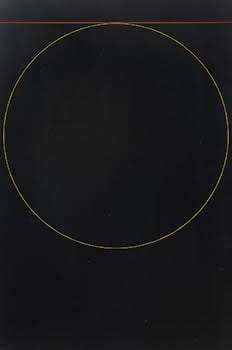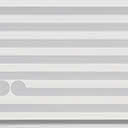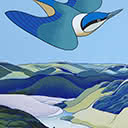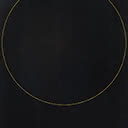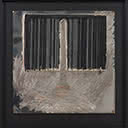Black Painting
90 x 59.5 cm
est. $80,000 - 120,000
PROVENANCE
Private Collection, Auckland
Acquired from Frances Hodgkins Fellow Exhibition,
Otago Museum, Dunedin, 1969 by the current
owner
EXHIBITED
Frances Hodgkins Fellow Exhibition, Otago
Museum, Dunedin, 1969
REFERENCE
Ralph Hotere, Kriselle Baker & Vincent O'Sullivan
(Ron Sang Publications, 2008) p.320
Despite being determinedly minimal and abstract, Hotere's black paintings from the late 1960s conjure memories of natural phenomena seen. Applied with a ruling pen to sit proud on the sprayed lacquer black ground, the simple red line and yellow circle in this work might seem to appear like images of an eclipsed moon and fiery sunset lighting up a horizon line.
There is a pleasing symmetry and balance, caused by the perfect placement of the straight line as a tangent to sit on the top of the large o shape which circumscribes the top two thirds of the work. Hotere's curved and straight lines in this series of works are clear and bright, painted as they are in primary colours, but very thin, which makes them appear like traces about to be swallowed up by the shiny black surrounds. As is typical for these works, the glossy surface here captures the viewer and reflects them back, in this instance surrounded by a penumbra of yellow. The black paintings come after Hotere's return from Europe where he went to study painting and graphic design at the Central School of Arts and Crafts in 1961. He spent a further year in Vence in the south of France on a fellowship, and travelled and exhibited in London before returning to Auckland and work as an art adviser in 1965. He became a full time artist four years later in 1969 when he was awarded the Frances Hodgkins Fellowship at the University of Otago in Dunedin, and his output was prolific. 27 black paintings were exhibited at the Barry Lett Gallery in September and he gifted his working drawings for the black paintings at the end of that year. Inscribed at the bottom of one page of 16 drawings of designs for paintings are the words Drawings for black paintings. Zero is round, zero is black, zero is zero.
Pakeha commentators on Hotere's work have remarked on the artist's citation of a quote from a lecture at the Institute of Contemporary Arts given by American abstractionist Ad Reinhardt (1913-1967) in the 1967 catalogue for his Zero paintings: The free-est and purest aesthetic statements of the twentieth century have been made in abstract painting. Although living in London at the time, Hotere had missed Reinhardt's talk, but would have admired his uncompromising stance on the purity of abstraction. However, some Maori writers have a different view of the artist's use of black and relate it to matauranga Maori. In curating Ralph Hotere's black paintings into his exhibition Toi Tū Toi Ora at Auckland Art Gallery, Nigel Borell placed the works deliberately in the first two sections which were titled Te Kore (the great nothingness) and Te Pō (the perpetual night). In so doing, Borell argues that the artist's use of the colour black may not be purely abstract and might allude to a suspended dimension that is full of potential and latent being. From this perspective, the fine lines of colour in these paintings might be allusions to Uenuku, the rainbow god, hinting at another cosmos beyond the visible.
LINDA TYLER

